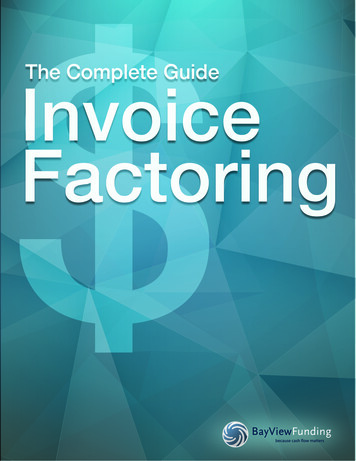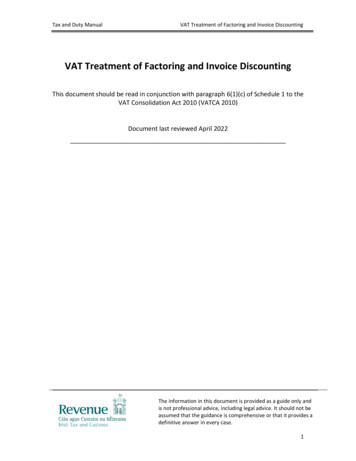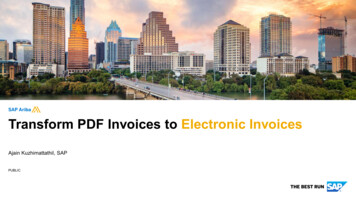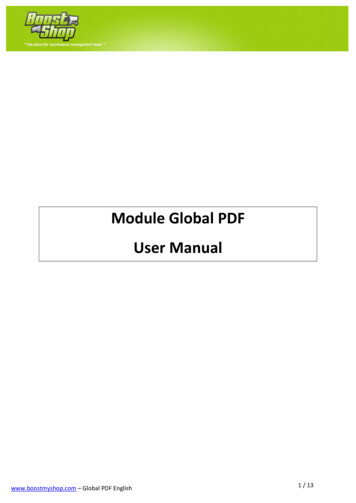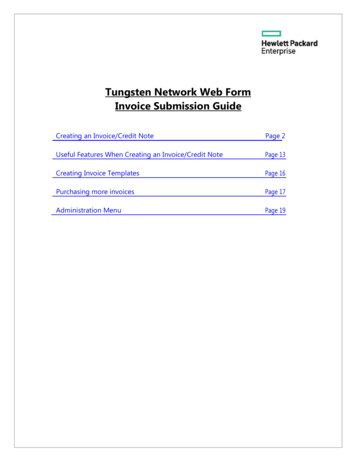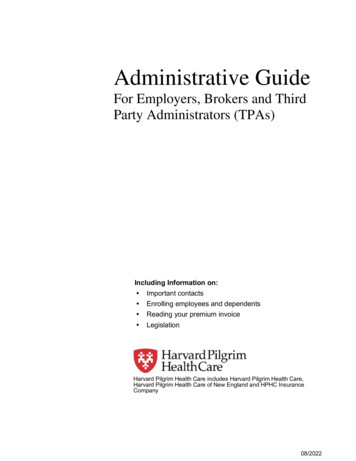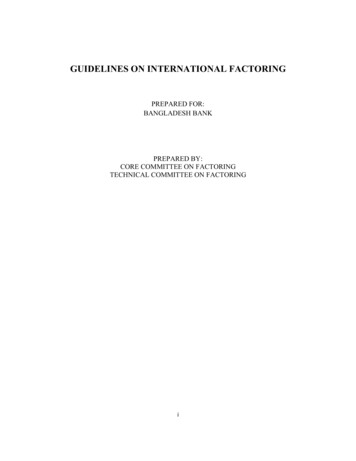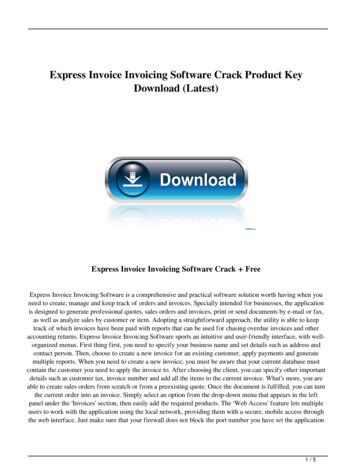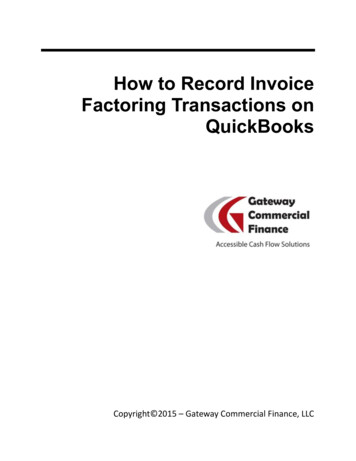
Transcription
How to Record InvoiceFactoring Transactions onQuickBooksCopyright 2015 – Gateway Commercial Finance, LLC
2Table of ContentsIntroduction . 3Chart of Accounts: Accounts You’ll Need . 4Step 1: Adding New Accounts to the Chart of Accounts . 5Creating Accounts Needed for Factoring . 6Step 2: Selling Invoices to the Factoring Company . 12Recording the Sale of an Invoice . 12Factoring With Recourse: Recording the Liability to the Factor . 17Step 3: Invoice collected by the Factoring Company . 20Factored Invoices: Invoice Collection . 20Recording Full Collections and Factoring Discount Fees . 20Recording Partial Collections and Factoring Discount Fees . 22Recording Partial Collections . 22Recording Factoring Discount Fees . 25Non-Factored Invoices: Invoice Collection . 26Step 4: Uncollectible Factored Invoices . 27Dealing with Charge-Backs from Factored Invoices. 27Recording Charge-Backs . 27Recording Factoring Discount Fees . 29Dealing with Bad Debts form Factored Invoices . 30Factoring With Recourse . 30Factoring Without Recourse . 32Step 5: Recording Account Charges and Fees . 34Recording Factoring Expenses . 34Recording Factoring Administrative Fees . 35Step 6: Recording Reserve Releases . 36Annex A: Explanation of Accounts. 37About Gateway Commercial Finance . 38Copyright 2015 Gateway Commercial Finance, LLC – Invoice Factoring Company -http://gatewaycfs.com
3INTRODUCTIONDisclaimer: The information available in this document is for informational purposes only and not for the purposeof providing accounting advice. You should contact your accountant to obtain professional advice regardingaccounting treatment of factoring transactions.Our ExampleWe’ll use the following transaction settings to work on our data entry examples in thisdocument:Factored invoice amount: 10,000Your company’s factoring advance rate: 80%Your company’s factoring discount fees: 3%Your uncollectible debt estimate: 5% (amount of invoices your company projects will beuncollectible)A few notes: We used QuickBooks PC Desktop Pro 2015 version for the sample transactions screenshots. Menuitems and functions may be located on a different place in other QB PC or Online versions. You mayneed to look for them.You are free to download this document, print it, distribute it, and post its content in your website,blogs or social media accounts as long as you attribute the work to Gateway Commercial Finance,LLC and link to our website http://gatewaycfs.comWe are open to suggestions to improve the content of this document. If you would like to contributeyour thoughts or have a different idea of how transactions should be recorded please email us togateway@gatewaycfs.com. Contributions included will be properly referenced.Enjoy!Copyright 2015 Gateway Commercial Finance, LLC – Invoice Factoring Company -http://gatewaycfs.com
4CHART OF ACCOUNTS: ACCOUNTS YOU’LL NEEDExisting accountsThe following accounts very likely already exist with a similar name in your QuickBooks chart ofaccounts and are already in use. If they don’t exist you may need to create them: Bank Checking Account (Type: Current Assets – Bank Account)Accounts Receivable (Type: Current Assets – Accounts Receivable)Sales Discounts (Type: Income)Bad Debts Expense (Type: Expenses)Allowance for Bad Debts (Type: Current Assets) - If your company uses Allowance for BadDebts Method to record uncollectible debt estimates instead of using a Direct Write-OffMethod for uncollectible debts.(*)New accounts for factoringThe following accounts need to be created to record factoring transactions: Factoring Holding Account (Type: Current Assets – Bank Account)Due From Factor (Type: Other Current Assets)Factoring Discount Fees (Type: Expenses)Factoring Administrative Fees (Type: Expenses)Factoring Expenses (Type: Expenses)Factoring Recourse Liability (Type: Other Current Liabilities) – Only if your company isFactoring With Recourse(*)Note: See Annex A for detailed explanation of accounts and Allowance for Bad Debts and DirectWrite-off MethodsCopyright 2015 Gateway Commercial Finance, LLC – Invoice Factoring Company -http://gatewaycfs.com
5STEP 1: ADDING NEW ACCOUNTS TO THE CHART OF ACCOUNTSTo add new accounts to the Chart of Accounts you’ll need to go to Lists Chart of Accounts.When the Chart of Accounts window opens go to “Account” on the bottom menu and click on“New”.Copyright 2015 Gateway Commercial Finance, LLC – Invoice Factoring Company -http://gatewaycfs.com
6Creating Accounts Needed for FactoringFactoring Holding AccountCopyright 2015 Gateway Commercial Finance, LLC – Invoice Factoring Company -http://gatewaycfs.com
7Due From FactorCopyright 2015 Gateway Commercial Finance, LLC – Invoice Factoring Company -http://gatewaycfs.com
8Factoring Discount FeesCopyright 2015 Gateway Commercial Finance, LLC – Invoice Factoring Company -http://gatewaycfs.com
9Factoring Administrative FeesCopyright 2015 Gateway Commercial Finance, LLC – Invoice Factoring Company -http://gatewaycfs.com
10General Factoring ExpensesCopyright 2015 Gateway Commercial Finance, LLC – Invoice Factoring Company -http://gatewaycfs.com
11Factoring Recourse Liability AccountCopyright 2015 Gateway Commercial Finance, LLC – Invoice Factoring Company -http://gatewaycfs.com
12STEP 2: SELLING INVOICES TO THE FACTORING COMPANY1- Recording the Sale of an InvoiceWhenever your factoring company buys one of your company’s invoices and wires the invoiceadvance agreed to your bank account you can record this transaction as follows:Our example 10000 invoice, 80% advance rate 8000 advance.Recording the sale of a receivableAccountDebitBank Checking Account8000Due From Factor2000Accounts ReceivableCredit10000Recording this transaction on Quickbooksa. Go to the invoice list and choose the invoice sold.Copyright 2015 Gateway Commercial Finance, LLC – Invoice Factoring Company -http://gatewaycfs.com
13When the invoice’s window opens go to “Receive Payments” and enter a payment for theamount advanced.In our example you’ll receive 8000 as an advance.b. Go to “Receive Payments”Copyright 2015 Gateway Commercial Finance, LLC – Invoice Factoring Company -http://gatewaycfs.com
14c. Record a payment for the advance amount to the Bank Checking AccountEnter a 8000 payment ( advanced amount)Bank Checking AccountCopyright 2015 Gateway Commercial Finance, LLC – Invoice Factoring Company -http://gatewaycfs.com
15The difference between the Invoice amount and the advanced amount, in our example 2000,needs to be applied to the “Due From Factor” account.d. Record a discount for the invoice amount minus the advance amount to the Due FromFactor accountTo make the recording of this transaction simple we’ll use the Invoice discount function torecord this transaction. On the invoice’s window click on “Discounts and Credits” on the top menu.Go to the “Discount” tab.Include the amount Due from Factor in the “Amount of Discount” field.Choose the “Due From Factor” account as Discount Account.Click on DoneCopyright 2015 Gateway Commercial Finance, LLC – Invoice Factoring Company -http://gatewaycfs.com
16After recording this transaction, the receivable will be taken off your books, your “BankChecking Account” balance will increase by 8000, and the “Due From Factor” account willincrease by 2000.Copyright 2015 Gateway Commercial Finance, LLC – Invoice Factoring Company -http://gatewaycfs.com
172- Factoring With Recourse: Recording the Liability to the Factoring CompanyIf your company is Factoring With Recourse you need to record a liability in case factoredinvoices are not collected as follows: Option I: if the your company uses Allowance for Bad Debts MethodOption II: if your company uses Direct Write-off MethodOPTION I- YOUR COMPANY USES ALLOWANCE FOR BAD DEBTS METHODOur example: 10000 invoice, 5% uncollectible receivables estimate, Recourse Liability 500 ( 10000*5%).AccountDebitAllowance for Bad DebtsFactoring Recourse LiabilityCredit500500Recording this transaction on QBa. Go to Make General Journal EntriesCopyright 2015 Gateway Commercial Finance, LLC – Invoice Factoring Company -http://gatewaycfs.com
18b. Record a debit for the invoice amount multiplied by the Uncollectible ReceivablesEstimate (%) to the Allowance for Bad Debts accountc. Record a credit for the same amount the Factoring Recourse Liability accountCopyright 2015 Gateway Commercial Finance, LLC – Invoice Factoring Company -http://gatewaycfs.com
19OPTION 2- YOUR COMPANY USES DIRECT WRITE-OFF METHODOur example: 10000 invoice, 5% uncollectible receivables estimate, Recourse Liability 500 ( 10000*5%).AccountBad Debts ExpenseFactoring Recourse LiabilityDebitCredit500500Recording this transaction on QBa. Go to Make General Journal Entriesb. Record a debit for the invoice amount multiplied by the Uncollectible ReceivablesEstimate (%) to the Bad Debts Expense accountc. Record a credit for the same amount the Factoring Recourse Liability accountCopyright 2015 Gateway Commercial Finance, LLC – Invoice Factoring Company -http://gatewaycfs.com
20STEP 3: INVOICE COLLECTED BY THE FACTORING COMPANYFACTORED INVOICES: INVOICE COLLECTIONA - Recording Full Collections and Factoring Discount FeesOur example: 10000 invoice, 8000 advanced, 3% Discount Fee 300( 10000*3%)Recording the payment & discount feesAccountFactoring Holding AccountFactoring DiscountDue From FactorDebitCredit17003002000Recording this transaction on QBa. Go to Make General Journal EntriesCopyright 2015 Gateway Commercial Finance, LLC – Invoice Factoring Company -http://gatewaycfs.com
21b. Record a debit for the Invoice reserve amount (invoice amount minus advancedamount) minus the Discount Fee to the Factoring Holding accountc. Record a debit for the Discount Fee to the Factoring Discount accountd. Record a credit for the invoice reserve amount to the Due from Factor accountCopyright 2015 Gateway Commercial Finance, LLC – Invoice Factoring Company -http://gatewaycfs.com
22B- Recording Partial Collections and Factoring Discount FeesB1- RECORDING PARTIAL COLLECTIONSCASE I: If amount collected equals invoice advanced amountOur example: Invoice 10000, Advanced Amount 8000, Payment 8000Partially reversing the saleAccountAccounts ReceivableDue From FactorDebitCredit20002000Recording this transaction on QBa. Go to Make General Journal Entriesb. Record a debit for the invoice amount minus the collected amount to the AccountsReceivable accountc. Record a credit for the invoice reserve amount to the Due From Factor accountCopyright 2015 Gateway Commercial Finance, LLC – Invoice Factoring Company -http://gatewaycfs.com
23CASE II: If payment amount is higher than invoice advance amountOur example: Invoice 10000, Advance Amount 8000, Payment 9000Partially reversing the sale & receiving positive differenceAccountDebitAccounts Receivable1000Factoring Holding Account1000Due From FactorCredit2000Recording this transaction on QBa. Go to Make General Journal Entriesb. Record a debit for the invoice amount minus the collected amount to the AccountsReceivable accountc. Record a debit for the collected amount minus the advance amount to theFactoring Holding accountd. Record a credit for the invoice reserve amount to the Due From Factor accountCopyright 2015 Gateway Commercial Finance, LLC – Invoice Factoring Company -http://gatewaycfs.com
24CASE III: If payment amount is lower than invoice advance amountOur example: Invoice 10000, Advance Amount 8000, Payment 6000Partially reversing the sale & paying back the differenceAccountAccounts ReceivableDebitCredit4000Factoring Holding Account2000Due From Factor2000Recording this transaction on QBa. Go to Make General Journal Entriesb. Record a debit for the invoice amount minus the collected amount to the AccountsReceivable accountc. Record a credit for the advance amount minus the collected amount to theFactoring Holding Accountd. Record a credit for the invoice reserve amount to the Due From Factor accountCopyright 2015 Gateway Commercial Finance, LLC – Invoice Factoring Company -http://gatewaycfs.com
25B2- RECORDING THE FACTORING DISCOUNT FEESRecording the discount feesAccountFactoring DiscountFactoring Holding AccountDebitCredit300(*)300(*)(*example) Discount fee amountRecording this transaction on QBa. Record a debit for the discount fee to the Factoring Discount accountb. Record a credit for the same amount to the Factoring Holding accountCopyright 2015 Gateway Commercial Finance, LLC – Invoice Factoring Company -http://gatewaycfs.com
26NON-FACTORED INVOICES: INVOICE COLLECTIONRecording Full or Partial PaymentsExample: The factoring company collects a 174 non-factored invoiceRecording a paymentAccountFactoring Holding AccountAccounts ReceivableDebitCredit174 (*)174(*)(*) Amount CollectedRecording this transaction on QBa. Open the invoice information (receive payments)b. Record a payment for the collected amount to the Factoring Holding AccountCopyright 2015 Gateway Commercial Finance, LLC – Invoice Factoring Company -http://gatewaycfs.com
27STEP 4: UNCOLLECTIBLE FACTORED INVOICESDEALING WITH CHARGE-BACKSRecording Factored Invoice Charge-BacksOur example: 10000 invoice, 8000 advanced, 300 factoring discount, 0 Collected.Reversing the sale and paying back amount advancedAccountAccounts ReceivableDebitCredit10000Due From Factor2000Factoring Holding Account8000Recording this transaction on QBa. Go to Make General Journal Entriesb. Record a debit for the invoice amount minus the collected amount to the AccountsReceivable accountc. Record a credit for the advance amount minus the collected amount to theFactoring Holding Accountd. Record a credit for the invoice reserve amount to the Due From Factor accountCopyright 2015 Gateway Commercial Finance, LLC – Invoice Factoring Company -http://gatewaycfs.com
28RECORDING FACTORING DISCOUNT FEES FOR CHARGE-BACKSRight after the charge-back has been recorded, the factoring discount fees charged by thefactor to the seller for each factored invoice have to be recorded too.Recording the discount feesAccountFactoring DiscountFactoring Holding AccountDebitCredit300(*)300(*)(*example) Discount fee amountCopyright 2015 Gateway Commercial Finance, LLC – Invoice Factoring Company -http://gatewaycfs.com
29Recording this transaction on QBc. Record a debit for the discount fee to the Factoring Discount accountd. Record a credit for the same amount to the Factoring Holding accountCopyright 2015 Gateway Commercial Finance, LLC – Invoice Factoring Company -http://gatewaycfs.com
30DEALING WITH BAD DEBTS FROM FACTORED INVOICESRight after a partial invoice collection, or charge-back has been recorded, if your companydecides the receivable debt is uncollectible you need to record the write-off of the amountunpaid.Seller Your companyOur example: 10000 invoice, collected 6000A- If your company is Factoring with RecourseAccountDebitFactoring Recourse Liability4000 (*)Accounts ReceivableCredit4000 (*)(*example) Uncollectible amount Invoice amount minus collected amountCopyright 2015 Gateway Commercial Finance, LLC – Invoice Factoring Company -http://gatewaycfs.com
31Recording this transaction on QBa. Go to Make General Journal EntriesRecord a debit for the invoice amount minus the collected amount to the FactoringRecourse Liability accountb. Record a credit for the same amount to the Accounts Receivable accountCopyright 2015 Gateway Commercial Finance, LLC – Invoice Factoring Company -http://gatewaycfs.com
32B- If your company is Factoring Without RecourseData entry depends on the method your company uses to write-off bad debt: Option I: Your company uses Allowance for Bad Debt MethodOption II: Your company uses Direct Write-off MethodOPTION I: If your company uses ALLOWANCE FOR BAD DEBTS METHODAccountDebitAllowance for Bad Debts4000 (*)Accounts ReceivableCredit4000(*)(*example) Uncollectible amount Invoice amount minus collected amountRecording this transaction on QBa. Go to Make General Journal Entriesb. Record a debit for the invoice amount minus the collected amount to the Allowancefor Bad Debts accountc. Record a credit for the same amount to the Accounts Receivable accountCopyright 2015 Gateway Commercial Finance, LLC – Invoice Factoring Company -http://gatewaycfs.com
33OPTION II- If your company uses DIRECT WRITE-OFF METHODAccountDebitBad Debts Expense4000 (*)Accounts ReceivableCredit4000 (*)(*example) Uncollectible amount Invoice amount minus collected amountRecording this transaction on QBa. Go to Make General Journal Entriesb. Record a debit for the invoice amount minus the collected amount to the BadDebts Expense accountc. Record a credit for the same amount to the Accounts Receivable accountCopyright 2015 Gateway Commercial Finance, LLC – Invoice Factoring Company -http://gatewaycfs.com
34STEP 5: RECORDING ACCOUNT CHARGES AND FEESRecording Factoring ExpensesWhenever your company is informed by the factor that a miscellaneous fee has beendiscounted from the reserve account, you can record the transaction as follows:Our example: 20 wire feeRecording the factoring expensesAccountFactoring ExpensesFactoring Holding AccountDebitCredit2020Recording this transaction on QBa. Record a debit for the factoring expense to the Factoring Expenses accountb. Record a credit for the same amount to the Factoring Holding accountCopyright 2015 Gateway Commercial Finance, LLC – Invoice Factoring Company -http://gatewaycfs.com
35Recording Administrative Factoring FeesWhenever your company is informed by the factoring company that an administrative fee hasbeen discounted from the reserve account you can record the transaction as follows:Example: 200 admin feeRecording the administrative feesAccountFactoring Administrative FeesFactoring Holding AccountDebitCredit200200Recording this transaction on QBa. Record a debit for the factoring administrative fees to the Factoring AdministrativeExpenses accountb. Record a credit for the same amount to the Factoring Holding accountCopyright 2015 Gateway Commercial Finance, LLC – Invoice Factoring Company -http://gatewaycfs.com
36STEP 6: RECORDING RESERVE RELEASESWhenever your company is informed by the factoring company that reserve amounts havebeen released and wired to your bank account, you can record the transaction as follows:Our example: 20000 reserve releaseRecording a reserve releaseAccountBank Checking AccountFactoring Holding AccountDebitCredit2000020000Recording this transaction on QBa. Record a debit for the amount released to the Bank Checking accountb. Record a credit for the same amount to the Factoring Holding accountCopyright 2015 Gateway Commercial Finance, LLC – Invoice Factoring Company -http://gatewaycfs.com
37ANNEX A: EXPLANATION OF ACCOUNTSBank Checking Account: the bank account your company uses to make and receive payments.Accounts Receivable: invoices from sales not yet collected.Sales Discounts: account or accounts used to record discounts on sales.Factoring Holding Account: account used as a temporary substitute of the bank checkingaccount when invoices are collected by the factoring company. It keeps the balance of cashheld at the factoring company’s reserve account.Due From Factor: balance the factoring company owes your company for the purchase of areceivable pending debtor payment.Factoring Discount Fee: account used to record invoice-related discount fees charged by thefactoring company at the time of invoice collection or charge-backs.Factoring Administrative Fee: account used to record account-related fees charged by thefactoring company based on account outstanding balance (usually a rate charged on thebalance of unpaid factored invoices).Factoring Expenses: account used to record miscellaneous factoring expenses such us wirefees, mailing fees, etc.Factoring Recourse Liability: account used by companies when factoring with recourse torecord an estimated liability to the factoring company in case invoices sold are not collected.Bad Debts Expense: expense account used to write-off uncollectible debt.Allowance for Bad Debts: contra current assets account associated with accounts receivableused when a company uses the Allowance for Bad Debts Method to write-off debt.Accounting Techniques of Bad Debts TreatmentAllowance for Bad Debts Method: the doubtful debts are estimated and bad debts expense isrecognized before the debts actually become uncollectible.Reference and more information: es/bad-debtsallowance-methodDirect Write-Off Method: accounts receivable are directly written-off against income when they areactually classified as uncollectible debts.Reference and more information: es/baddebts-direct-write-off-methodCopyright 2015 Gateway Commercial Finance, LLC – Invoice Factoring Company -http://gatewaycfs.com
38ABOUT GATEWAY COMMERCIAL FINANCE – FACTORING COMPANYLOOKING FOR A NEW FACTORING COMPANY? HERE ARETHE BENEFITS THAT ONLY GATEWAY CAN OFFER YOURCOMPANYHigh Customer SatisfactionWe truly care about your business. Our customer retention rate isalmost TWICE (1.9 times) the industry average. Our customersvalue our services and stay with us much longer.Direct Access to Decision MakersBecause the company's owners are also the managers, from your first call, you’ll work directly with adecision maker. No brokers, no sales people, no credit committee, no underwriters, simply . straightanswers and fast decisions!Fast and Reliable FundingWe’re a financially stable funding provider. Working with us you’ll have the confidence that you’ll havefunds available whenever you need them.We Protect Your Business’ ReputationWe care about your reputation with your customers and work hard to preserve your image. Ourtransparent servicing is truly unique from other factoring companies. We’ve invested heavily in state ofthe art technology and our people to ensure your reputation remains preserved.Transparency is the foundation of our continuous growth. We deliver what we promise.Ready to get started? Call Marc J.Marin, Managing Director now andbegin experiencing the omCopyright 2015 Gateway Commercial Finance, LLC – Invoice Factoring Company -http://gatewaycfs.com
accounting treatment of factoring transactions. Our Example We'll use the following transaction settings to work on our data entry examples in this document: Factored invoice amount: 10,000 Your company's factoring advance rate: 80% Your company's factoring discount fees: 3%

